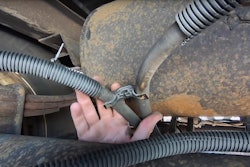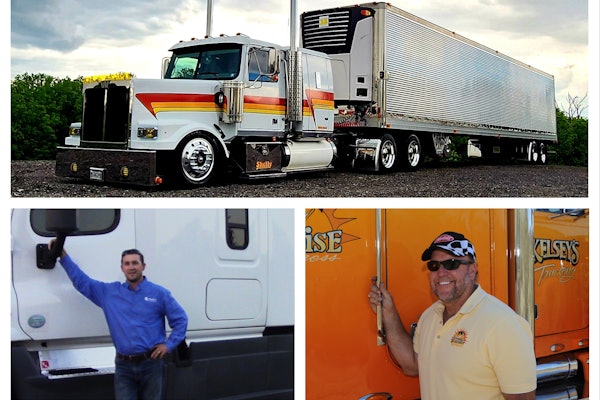At the Specialized Carriers and Rigging Association's annual conference each year in the Spring, the association unveils both the rigging and hauling jobs of the previous year that were the most exceptional among its membership via the annual Jobs of the Year awards. The winners are always eye-opening when it comes to the sheer complexity of every move, the equipment modifications often required, and massive amounts of coordination required to pull them off.
The 2023 winners will be unveiled at SCRA's annual conference, slated for April 17-21 in Carlsbad, California, but at the Specialized Transportation Symposium earlier this month in Orlando, Florida, a special session highlighted last year's winners in four categories. Each category is judged on safety, planning and execution of the job.
Under 160,000 lbs.
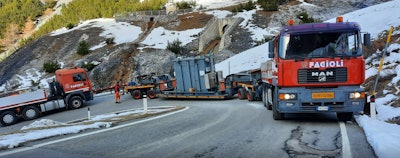 Five personnel from Fagioli. S.P.A. were dedicated to this award-winning move, shown here negotiating one of dozens of hairpin, uphill turns the convoy made on its way up to the highest paved pass in the Eastern Alps.
Five personnel from Fagioli. S.P.A. were dedicated to this award-winning move, shown here negotiating one of dozens of hairpin, uphill turns the convoy made on its way up to the highest paved pass in the Eastern Alps.
The Italy-headquartered Fagioli S.P.A. won this category with a move of a 29-ton transformer from a site in Northeast Italy to a power plant, with perhaps the most challenging of legs a run up the mountain with dozens of hairpin turns that proved extra-difficult to execute up to the highest paved pass in the Eastern Alps. A very old, 23-meter-long bridge might come in a close second for degree of difficulty, given the company had to custom-build its own steel span with girders on which to effectively lift the freight and roll it across and back to trailer.

A couple more hairpin turns, 12 small tunnels along the way, and the power station was in sight. Equipment used on the five-day journey included the four-axle trailer with steering axles, heavily modified to keep the load steady around the hairpin curves.
160,000 to 500,000 lbs.
Oregon-headquartered Emmert International was recognized in this category for its move of five wind turbine generators -- fully loaded 18' high, 16' wide and 127' long -- from Burns Harbor, Indiana, to a wind farm site in Compton, Illinois. Each generator weighed 223,000 lbs., and the team had to negotiate numerous small bridges and culverts that couldn't fully support the cargo weight along a circuitous 270-mile route. Road construction precluded a much shorter route that could have worked in this case, and ultimately the lengthening led to Emmert coordinating with more than 30 different entities, from cities to railroad companies, police departments and pilot car companies.
A multitude of low branches had to be cleared, too, along the route. Five turbines moved over the course of three weeks with no incidents.
Greater than 500,000 lbs.
The Transportes Mucino company in Hidalgo, Mexico, took home honors in this category with moves of massive equipment from a port to the largest power plant in Latin America. Freight included a 380-metric-ton (almost 840,000 lb.) generator and a gas turbine weighing in at 340 metric tons (almost 750,000 lbs.). Both loads had to be reconfigured en route at different locations to make the full traversal into the mountains to San Luis Potosi, Mexico, for Hitachi Power Systems. The route featured 126 tight curves, and six bridges had to be reinforced, others outfitted with high bridge girders to make it all work. A pedestrian bridge was lifted to allow the convoy to pass in one instance, too.
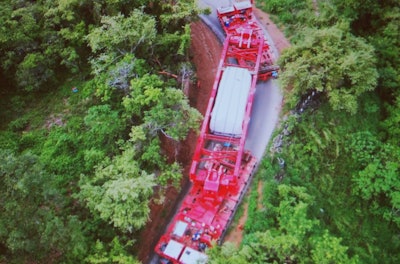 A mixture of trucks and self-propelled moving equipment provided the power, and 12 months of preparation went into the project -- a grand total of 8,000 planning hours.
A mixture of trucks and self-propelled moving equipment provided the power, and 12 months of preparation went into the project -- a grand total of 8,000 planning hours.
Two National Guard patrols, two front and three rear pilot cars were involved, and road moves were made in daytime only.
The first load took 30 days to travel the 239 kilometers of the trip. The second load took 20 days. A team of 30 people made up the crew on each trip.
Moving category
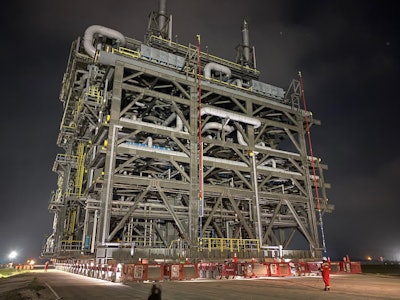 250' tall, 190' long and 150' wide. These on-shore furnaces are "some of the biggest things to be moved this far" on land, said Mammoet's team lead on this five-mile move from the coast inland to a pastics facility in Texas.
250' tall, 190' long and 150' wide. These on-shore furnaces are "some of the biggest things to be moved this far" on land, said Mammoet's team lead on this five-mile move from the coast inland to a pastics facility in Texas.
Mammoet Americas was honored in this category, reserved for the most complex of moving projects, for parts of a series of heavy hauls of 195 loads over the course of three years, including the largest on-shore furnace modules headed to a plastics manufacturing complex approximately fives miles inland from the Gulf Coast in Texas. How big was the largest of them? 250' tall, 190' long and 150' wide, weighing 40 times the weight of the Statue of Liberty, Mammoet reps noted in their presentation. Those modules moved on propelled equipment, an astounding number of axles and tires and an approximate five-mile heavy haul road that was purpose-built for them. The trip moved from a custom offload dock at the coastline inland to the facility.
The dedicated route had two major roadway crossings, with those crossings executed in the night hours. There was major rain during the move, but thankfully no lightning strikes.
The engineering team lead at Mammoet, Adam Bettis, noted he essentially spent three years of his career dedicated to executing the project, moving his family to the area in the process -- its planning stretches back farther, all the way to 2016, and during execution, Mammoet’s team logged a grand total of about 42,000 incident-free man-hours. These are "some of the biggest things to be moved this far," Bettis added.




